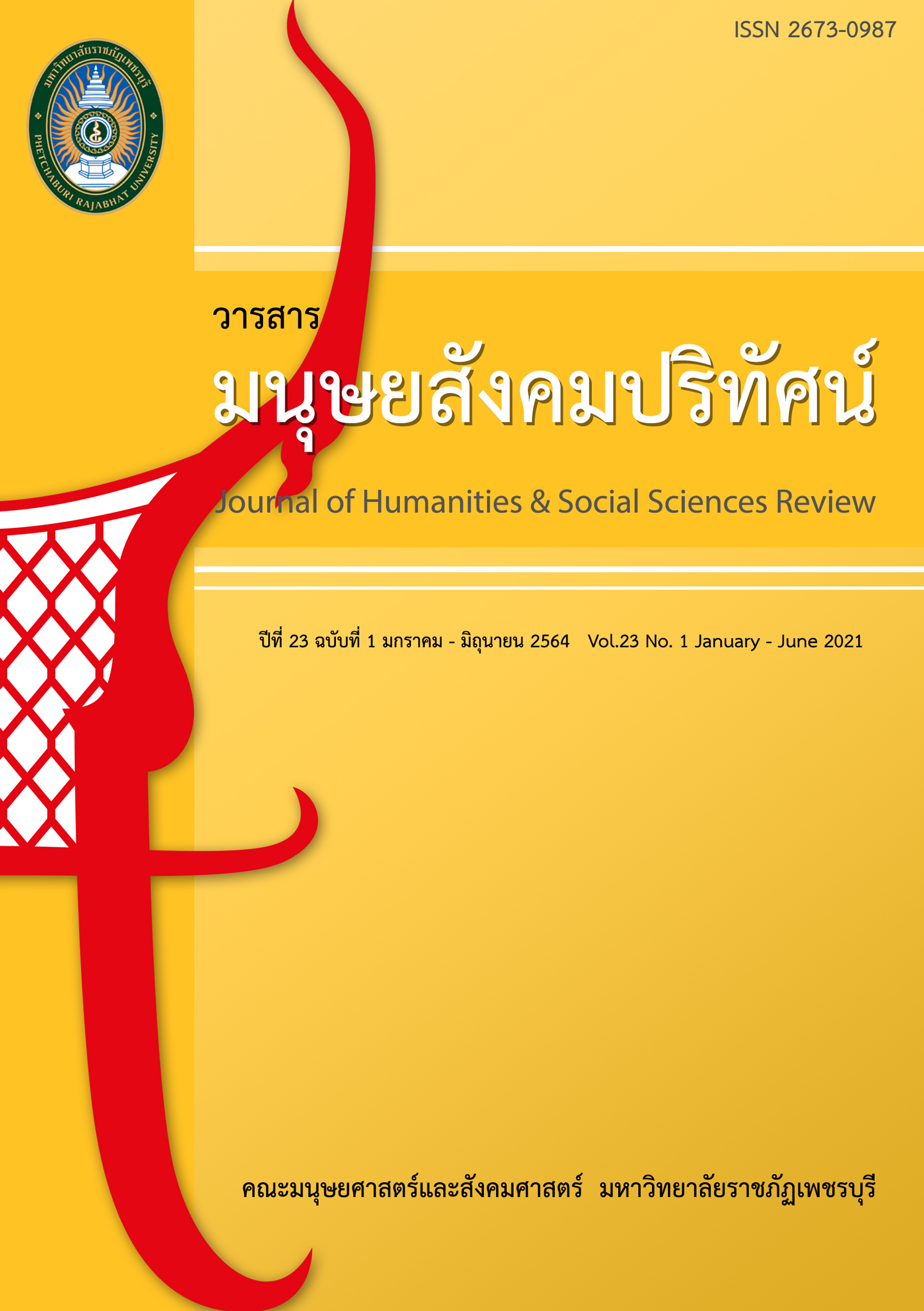การวิเคราะห์วรรณกรรมเซียมซีของวัดในเขตอำเภอเมือง จังหวัดเพชรบุรี
Main Article Content
บทคัดย่อ
การวิเคราะห์วรรณกรรมเซียมซีของวัดในเขตอำเภอเมือง จังหวัดเพชรบุรี เพื่อศึกษาลักษณะของวรรณกรรมเซียมซีที่ปรากฏของวัดในเขตอำเภอเมือง จังหวัดเพชรบุรี และศึกษาวรรณกรรมเซียมซีของวัดในเขตอำเภอเมือง จังหวัดเพชรบุรี ในด้านรูปแบบ เนื้อหา การใช้ภาษา และคุณค่าที่ได้รับ ข้อมูลสำหรับการศึกษาวิจัยเป็นใบเซียมซีที่พบที่วัดในเขตอำเภอเมือง จังหวัดเพชรบุรี จำนวน 12 วัด จากจำนวนวัดทั้งหมด 75 วัด วัดละ 28 ใบ รวม 336 ใบ ผลการศึกษาพบว่า ลักษณะของใบเซียมซีในทุกวัดจะมี 28 ใบ โดยทางวัดไปซื้อจากสำนักพิมพ์ที่กรุงเทพฯ และบางวัดมาจัดพิมพ์เอง ใบเซียมซีแต่ละหมายเลขมีลักษณะผสมกัน หมายเลขหนึ่งๆ จะมี 2 – 4 ใบ มีลักษณะการเขียนที่แตกต่างกัน แต่จะมีเนื้อหาในใบนั้นๆ ใกล้เคียงกัน ด้านรูปแบบของใบเซียมซี จะมี 2 ส่วน ที่ระบุชื่อวัดหรือสิ่งศักดิ์สิทธิ์ ระบุหมายเลขและเนื้อหาคำทำนาย จบด้วยการอวยพร ส่วนมากพิมพ์เป็น 3 ภาษา คือ ภาษาไทย ภาษาอังกฤษ และภาษาจีน ส่วนรูปแบบการเขียนเป็นกลอนสุภาพ จำนวน 11 – 20 วรรค ๆ ละ 5 – 11 คำ ที่พบมากที่สุดคือ 8 คำ ส่วนเนื้อหาจะมี 2 ส่วน ส่วนที่ 1 เป็นการทำนายเหตุการณ์ หรือโชคชะตาต่างๆ ที่เกี่ยวข้องกับการดำเนินชีวิตใน 8 ด้าน คือ ด้านโชคลาภ ที่มีเนื้อหามากที่สุด รองลงมาคือ ด้านเนื้อคู่ โชคร้าย โรคภัยไข้เจ็บ การเงิน ญาติพี่น้อง การมีบุตร การทำงาน ตามลำดับ ส่วนที่ 2 เป็นคำเตือนหรือชี้แนะแนวทางพร้อมการแก้ไข นอกจากนี้เนื้อหาในภาพรวมจะมี 3 ด้าน คือ ด้านดี ปานกลาง และไม่ค่อยดี สำหรับการใช้ภาษา จะเด่นด้านสุนทรียรสด้วยการใช้คำสัมผัสใน แบบสัมผัสสระ ได้แก่ คำเคียง คำเทียบเคียง คำทบเคียง คำแทรกเคียง คำแทรกแอก และการสัมผัสพยัญชนะ ได้แก่ คำคู่ คำเทียบคู่ คำเทียบรถ คำทบคู่ คำแทรกคู่ และคำแทรกรถ การใช้สำนวน การใช้คำซ้ำ การใช้คำซ้อน การใช้ความเปรียบเทียบ การใช้คำคู่ การใช้คำศัพท์ที่มีความไพเราะ ใบเซียมซีจึงถือเป็นมรดกทางวัฒนธรรมที่มีคุณค่าในด้านวรรณศิลป์ ด้านคติธรรมคำสอน และคุณค่าทางสังคม
Article Details
1. มุมมองและความคิดเห็นใด ๆ ในบทความเป็นมุมมองของผู้เขียน คณะบรรณาธิการไม่จำเป็นต้องเห็นด้วยกับมุมมองเหล่านั้นและไม่ถือเป็นความรับผิดชอบของคณะบรรณาธิการ ในกรณีที่มีการฟ้องร้องเกี่ยวกับการละเมิดลิขสิทธิ์ ให้ถือเป็นความรับผิดชอบของผู้เขียน แต่เพียงผู้เดียว
2. ลิขสิทธิ์บทความที่เป็นของคณะมนุษยศาสตร์และสังคมศาสตร์ มหาวิทยาลัยราชภัฏเพชรบุรีมีลิขสิทธิ์ถูกต้องตามกฎหมาย การเผยแพร่จะต้องได้รับอนุญาตโดยตรงจากผู้เขียนและมหาวิทยาลัยราชภัฏเพชรบุรีเป็นลายลักษณ์อักษร
เอกสารอ้างอิง
2. กุหลาบ มัลลิกะมาส. (2517). วรรณกรรมไทย. พระนคร : โรงพิมพ์ส่วนท้องถิ่น.
3. จินตนา ธันวานิวัฒน์. (2542). ภาษาเซียมซี. วารสารอักษรศาสตร์, 28(ฉบับพิเศษ): 124-150.
4. ชาคริต อนันทราวัน. (2539). วรรณกรรมเซียมซี. กรุงเทพฯ: โอเดียนสโตร์.
5. ดรุณี เดชานุสรณ์. (2541). วิเคราะห์ศาสตราและเซียมซีที่พบในจังหวัดภาคใต้ฝั่งทะเลตะวันตก. วิทยานิพนธ์การศึกษามหาบัณฑิต สาขาวิชาภาษาไทย, มหาวิทยาลัยทักษิณ.
6. ต่อศักดิ์ เกษมสุข. (2556). วรรณกรรมใบเซียมซีไทยและลาว. วารสารบัณฑิตศึกษา, 12(56): มกราคม – มีนาคม 2558..
7. พรทิพย์ ไวแสง. (2535). ความสัมพันธ์ระหว่างภาษาและวัฒนธรรมที่ปรากฎในคำทำนายของใบเซียมซี. ปริญญานิพนธ์การศึกษามหาบัณฑิต สาขาวิชาภาษาศาสตร์การศึกษา มหาวิทยาลัยศรีนครินทรวิโรฒ.
8. เพ็ญศรี บูรพาวิจิตรนนท์. (2539). วิเคราะห์ภาพพจน์ เนื้อหา และความเชื่อจากใบเซียมซีของวัดในภาคเหนือ. ปริญญานิพนธ์การศึกษามหาบัณฑิต สาขาวิชาภาษาไทย มหาวิทยาลัยนเรศวร.
9. พระมหาวรพจน์คัมภีรปัญโญ ผู้ช่วยเจ้าอาวาสวัดมหาธาตุวรวิหาร อำเภอเมือง จังหวัดเพชรบุรี, สัมภาษณ์ เมื่อ 3 มิถุนายน 2564.
10. ปิยมาศ กังวานกิจไพศาล. (2550). การเสี่ยงเซียมซี : พิธีกรรมแห่งการสื่อสารความหมาย. วิทยานิพนธ์การศึกษามหาบัณฑิต สาขาวิชาภาษาไทย มหาวิทยาลัยธรรมศาสตร์.
11. ประยงค์ อนันทวงศ์. (2526). แลหลังจีน. กรุงเทพฯ: รวมสาส์น.
12. มหาวิทยาลัยสุโขทัยธรรมาธิราช. (2561). ภาษาไทย 2 : การประพันธ์ไทย. กรุงเทพฯ : บริษัทรุ่งศิลป์การพิมพ์.
13. มะลิ จรุงเกียรติ. (2549). การศึกษาวรรณกรรมใบเซียมซีของวัดในจังหวัดภาคกลาง. สารนิพนธ์การศึกษามหาบัณฑิต สาขาภาษาไทย มหาวิทยาลัยศรีนครินทรวิโรฒ.
14. ราชบัณฑิตยสถาน. (2561). พจนานุกรมฉบับราชบัณฑิตสถาน พ.ศ.2554 เฉลิมพระเกียรติพระบาทสมเด็จพระเจ้าอยู่หัว เนื่องในโอกาสพระราชพิธีมหามงคลเฉลิมพระชนมพรรษา 7 รอบ 5 มกราคม 2554. กรุงเทพฯ: ราชบัณฑิตสถาน 2556.
15. ละออง มีเศรษฐี. (2528). ชุมนุมวรรณกรรมทำนายของโหร กวีไทย. กรุงเทพฯ: รุ่งเรืองสาส์นการพิมพ์.
16. ลักษณณีวไล ภูษาวิโศธน์. (2550). เซียมซี การใช้คำ สำนวน และโวหารภาพพจน์. วารสารภาษาไทยและวัฒนธรรมไทย. 2(1): ธันวาคม – พฤษภาคม.
17. ลักษณณีวไล ภูษาวิโศธน์. (2551). ศึกษาการใช้ภาษาและเนื้อหาในใบเซียมซี. ปริญญาศิลปศาสตรมหาบัณฑิต สาขาวิชาภาษาไทย มหาวิทยาลัยเกษตรศาสตร์.
18. วิมล คำศรี. (2554). วรรณกรรมใบเซียมซีเมืองนครศรีธรรมราช: การศึกษาเชิงวิเคราะห์. ศูนย์ศิลปวัฒนธรรมสถาบันราชภัฏนครศรีธรรมราช.
19. วิเชียร เกษประทุม. (2541). ลักษณะคำประพันธ์ไทย. กรุงเทพฯ: บริษัทวิสิทธิ์พัฒนาจำกัด.
20. วาสนา บุญสม. (2541). กลอนเซียมซี เสี่ยงทาย. ความรู้คือประทีป, 2(เมษายน-มิถุนายน 2541).
21. สมาน สุดโต. (2563). วัดกัลยาณมิตรเป็นต้นแบบเซียมซีในสำนักต่างๆ. ค้นเมื่อ มกราคม 14, 2563, จาก Post Today.
22. สรียา ทับทัน. (2549). เซียมซีอิเล็กทรอนิกส์: นวัตกรรมใหม่ บนรากฐานของความเชื่อเดิม. วารสารสุโขทัยธรรมาธิราช, 19(2): กรกฎาคม-ธันวาคม 2549.
23. สโรชา รัตนเพียร. (2560). บทวิเคราะห์คำทำนายเซียมซีในบริบทสังคมไทย. วารสารมนุษยศาสตร์สังคมศาสตร์. 34(1): มกราคม-เมษายน 2560.
24. สุทธิพงษ์ นามเกิด. (2549). โวหาร ภาพพจน์ เนื้อหา และความเชื่อที่ปรากฏในใบเซียมซี ในอำเภอเมือง จังหวัดลพบุรี. สารนิพนธ์ศิลปศาสตรมหาบัณฑิต สาขาภาษาไทย, มหาวิทยาลัยราชภัฏเทพสตรี.
25. สุปรียา หัสชู. (2553). ลักษณะพิธีกรรม ความหมายเรื่องความศักดิ์สิทธิ์และบทบาทของเซียมซีในสื่อออนไลน์. วิทยานิพนธ์นิเทศศาสตรมหาบัณฑิต คณะนิเทศศาสตร์ จุฬาลงกรณ์มหาวิทยาลัย.
26. สำนักงานพระพุทธศาสนาจังหวัดเพชรบุรี. (2563). ข้อมูลวัดและเจ้าอาวาสจังหวัดเพชรบุรี. เพชรบุรี: สำนักงานพระพุทธศาสนาจังหวัดเพชรบุรี.
27. หลง ใส่ลายสือ. (2545). คนเล็กๆ ผู้ให้กำเนิดเซียมซี ภาษาไทยคำกลอน. ศิลปวัฒนธรรม, 11(กันยายน): 45-46.
28. องค์การส่งเสริมการท่องเที่ยวแห่งประเทศญี่ปุ่น. (2563). “ลองไปเสี่ยง” “เซียมซี” (Omikuji) ที่วัดและศาลเจ้ากันเถอะ. ค้นเมื่อ มกราคม 14, 2563, จาก http://www.jnto.or.th/e-mewsletter-subseribe/.
29. Lostatas 89. (2563). เซียมซี ความเชื่อที่มาจากการเสี่ยงทาย. ค้นเมื่อ มกราคม 14, 2563, จาก Wecomics.in.th.


